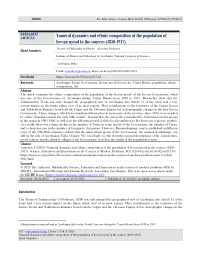Numeral dynamics and ethnic composition of the population of Irevan uyezd in the sources (1850-1917)
Автор: Amrahov Z.
Журнал: Science, Education and Innovations in the Context of Modern Problems @imcra
Статья в выпуске: 7 vol.8, 2025 года.
Бесплатный доступ
The article examines the ethnic composition of the population of the Irevan uyezd1 of the Irevan Governorate, which was one of the Governorates of Azerbaijan during Tsarist Russia, from 1849 to 1917. Researches show that the Turkmenchay Treaty not only changed the geographical view of Azerbaijan, also Article 15 of the treaty had a very serious impact on the future ethnic view of its most regions. Mass resettlements to the territories of the former Irevan and Nakhchivan khanates from both the Gajars and the Ottoman Empire led to demographic changes in the later Irevan Governorate. These changes, which have manifested themselves in most parts of the province since 1850, were marked by ethnic cleansing towards the early 20th century. In particular, the genocides committed by Armenian terrorist groups in the region in 1905-1906, as well as in the following period, led the local population to flee from one region to another. As a result, there was a sharp decline in the number of Tatars in some uyezds of the Governorate, the number of Tatars, and a sharp increase in the number of foreigners, Armenians. However, Russian-language sources published in different years of the 19th-20th centuries confirm that the main ethnic group of the Governorate, the numerical advantage, was still on the side of Azerbaijani Turks (Tatars). We can clearly see this from the cameral descriptions of the central cities, uyezd centers, uyezds, districts, villages of the Governorate, as well as the results of the population census.
Azerbaijan, Irevan Governorate, Irevan uyezd, Irevan city, Tsarist Russia, population, ethnic composition, city
Короткий адрес: https://sciup.org/16010887
IDR: 16010887 | DOI: 10.56334/sei/8.7.65


